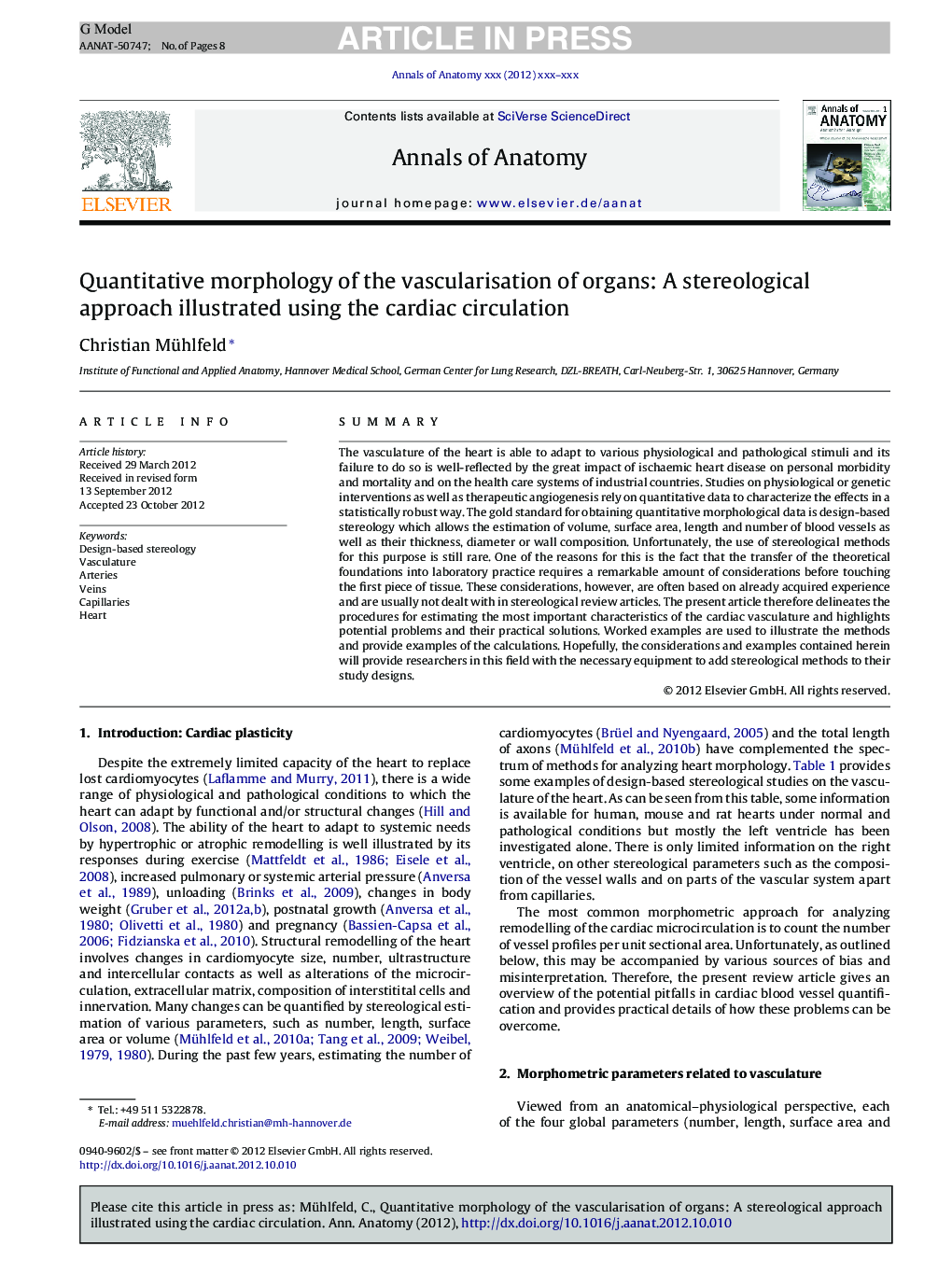| کد مقاله | کد نشریه | سال انتشار | مقاله انگلیسی | نسخه تمام متن |
|---|---|---|---|---|
| 8461231 | 1549004 | 2014 | 8 صفحه PDF | دانلود رایگان |
عنوان انگلیسی مقاله ISI
Quantitative morphology of the vascularisation of organs: A stereological approach illustrated using the cardiac circulation
ترجمه فارسی عنوان
مورفولوژی کمی از عروق مجاری ارگان: رویکرد استریولوژیک با استفاده از گردش خون قلبی نشان داده شده است
دانلود مقاله + سفارش ترجمه
دانلود مقاله ISI انگلیسی
رایگان برای ایرانیان
کلمات کلیدی
استریولوژی مبتنی بر طراحی، متابولیسم، شریان ها، رگها، موی سر قلب،
ترجمه چکیده
عروق قلب قادر به سازگاری با محرک های مختلف فیزیولوژیکی و آسیب شناسی است و عدم موفقیت آن به واسطه تاثیر عظیم بیماری های قلبی ایسکمیک بر بیماری های شخصی و مرگ و میر و سیستم های مراقبت های بهداشتی کشورهای صنعتی، منعکس می شود. مطالعات مربوط به مداخلات فیزیولوژیکی یا ژنتیکی و همچنین آنژیوژنز درمانی بر روی داده های کمی برای تعیین اثرات به روش آماری قوی متکی هستند. استاندارد طلا برای به دست آوردن داده های مورفولوژیکی کمی بر اساس استریولوژی مبتنی بر طراحی است که اجازه می دهد برآورد حجم، سطح، طول و تعداد عروق خونی و همچنین ضخامت، قطر و یا ترکیب دیواره آنها. متاسفانه استفاده از روش های استریولوژیک برای این منظور هنوز نادر است. یکی از دلایل این امر این واقعیت است که انتقال مبانی نظری به آزمایشگاه نیازمند مقدار قابل توجهی از ملاحظات قبل از دست زدن به اولین قطعه بافت است. با این حال، این ملاحظات اغلب بر مبنای تجربه در حال حاضر به دست آمده و معمولا در مقالات بازبینی استرس زا نیستند. بنابراین مقاله حاضر روشهای تخمین مهمترین ویژگیهای عروق قلب را مشخص می کند و مشکلات بالقوه و راه حل های کاربردی آن را برجسته می کند. مثال های کار شده برای نشان دادن روش ها و ارائه نمونه هایی از محاسبات استفاده می شود. امیدوارم، ملاحظات و نمونه هایی که در اینجا ارائه می شود، محققان در این زمینه را با تجهیزات لازم برای افزودن روش های استریولوژیکی به طرح های مطالعه خود ارائه می دهند.
موضوعات مرتبط
علوم زیستی و بیوفناوری
بیوشیمی، ژنتیک و زیست شناسی مولکولی
بیولوژی سلول
چکیده انگلیسی
The vasculature of the heart is able to adapt to various physiological and pathological stimuli and its failure to do so is well-reflected by the great impact of ischaemic heart disease on personal morbidity and mortality and on the health care systems of industrial countries. Studies on physiological or genetic interventions as well as therapeutic angiogenesis rely on quantitative data to characterize the effects in a statistically robust way. The gold standard for obtaining quantitative morphological data is design-based stereology which allows the estimation of volume, surface area, length and number of blood vessels as well as their thickness, diameter or wall composition. Unfortunately, the use of stereological methods for this purpose is still rare. One of the reasons for this is the fact that the transfer of the theoretical foundations into laboratory practice requires a remarkable amount of considerations before touching the first piece of tissue. These considerations, however, are often based on already acquired experience and are usually not dealt with in stereological review articles. The present article therefore delineates the procedures for estimating the most important characteristics of the cardiac vasculature and highlights potential problems and their practical solutions. Worked examples are used to illustrate the methods and provide examples of the calculations. Hopefully, the considerations and examples contained herein will provide researchers in this field with the necessary equipment to add stereological methods to their study designs.
ناشر
Database: Elsevier - ScienceDirect (ساینس دایرکت)
Journal: Annals of Anatomy - Anatomischer Anzeiger - Volume 196, Issue 1, January 2014, Pages 12-19
Journal: Annals of Anatomy - Anatomischer Anzeiger - Volume 196, Issue 1, January 2014, Pages 12-19
نویسندگان
Christian Mühlfeld,
